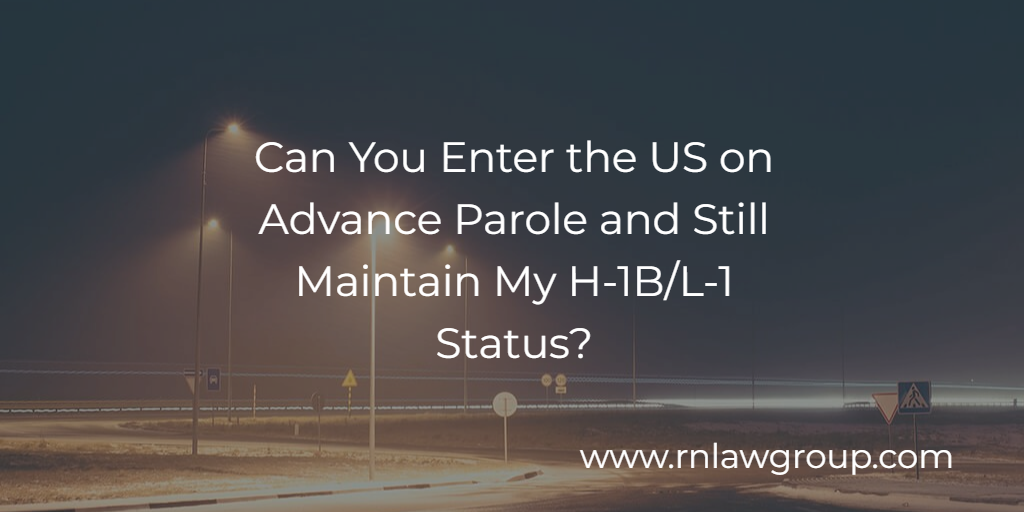
Can You Enter the US on Advance Parole and Still Maintain My H-1B/L-1 Status?
While it is not always necessary to maintain your non-immigrant status after filing your I-485 and receiving your (c)(9) EAD and advance parole, there are some reasons an individual may want to do so. First, for those that have an I-140 still pending, maintaining the underlying non-immigrant status may be important in case the I-140 gets denied. If the underlying I-140 ends up getting denied, ultimately so too will the I-485. Thus, if you have maintained non-immigrant status, you do not have to depart the country and can just maintain that non-immigrant status. Second, you must be in a valid non-immigrant status in order to file a new I-485. So, if you have filed in EB-3 and want to refile in EB-2, you would have to maintain your non-immigrant status in order to do so.
So, what happens to your non-immigrant status if your EAD and AP are approved, you travel overseas while the I-485 is pending, and come back in on your AP? If you are on a non-immigrant status that is NOT in H-1 or L-1 status, or the appropriate dependent status, you are now “married” to the pending green card application and can remain in the US pursuant to your pending I-485 and work pursuant to the (c)(9) EAD. If you are on H or L status, enter the Cronin Memo from 2000 from legacy INS.
The 2000 memo from then INS Acting Associate Commissioner for the Office of Programs Michal D. Cronin provided a memo to personnel regarding updates to the Adjudicator’s Field Manual. These updates provided the field officers guidance about the interim final rule published on June 1, 1999 at 64 Fed. Reg. 29,208 (1999) titled “Adjustment of Status; Continued Validity of Nonimmigrant Status, Unexpired Employment Authorization, and Travel Authorization for Certain Applicants Maintaining Nonimmigrant H or L Status.” The text of the comments of the regulation can be found here: https://www.govinfo.gov/app/details/FR-1999-06-01/99-13759
The Cronin Memo contains guidance on what happens if an H or L visa holder is “paroled” into the US that allows them to extend their H or L status. One quick note, while on its face, the Cronin Memo appears to be superseded by the regulations, which don’t address this situation, in practice, based on reports of multiple attorneys both in and out of our office, USCIS is still seemingly applying the memo’s guidance.
This memo provides guidance to USCIS that allows H and L non-immigrants that left while in status to reenter under advance parole to “extend” their non-immigrant status. Specifically, the memo states:
…An alien who was an H-1 or L-1 nonimmigrant, but who was paroled pursuant to a grant of advance parole, may apply for an Extension of H-1 or L-1 status, if there is a valid and approved petition. If the Service Approves the alien’s application for an extension of nonimmigrant status, the decision granted such an extension will have the effect of terminating the grant of parole and admitting the alien in the relevant nonimmigrant classification.
Again, this is not specifically codified in the regulation that was eventually published, but there seems to be some anecdotal evidence that this is working in practice. The question often becomes, if you are admitted in advance parole status, how can you extend your non-immigrant status? One solution our office recommends is that you utilize automatic revalidation to get back into non-immigrant status.
Using an example, Person A has a valid H-1B I-94, but an expired H-1B visa stamp, and is working pursuant to that H-1B while their I-485 is pending. Person A’s advance parole associated with the pending I-485 is approved. Person A has an urgent need to travel to India but does not want to wait for a visa appointment to get a new H-1B visa stamp to return to the US. Person A travels to India, handles the urgent matter, and re-enters the US using the advance parole. However, Person A wants to maintain their non-immigrant status.
At this stage, there are two options for an individual to maintain their non-immigrant status. The, potentially overly so, conservative approach would be to utilize automatic revalidation. With this option, once Person A has paroled in, Person A could travel to Mexico with the expired H-1B visa stamp, but the valid H-1B I-797 I-94, and use automatic revalidation to enter back in on H-1B status. Doing this puts Person A back in H-1B status with the I-485 still pending. More information about automatic revalidation can be found here: https://www.rnlawgroup.com/644-automatic-revalidation-exception-to-re-entering-the-united-states-with-a-valid-i-94-and-expired-visa/
However, a simpler method is provided for in the Cronin Memo, and reports from multiple attorneys have indicated that this method works and has worked recently. The Cronin Memo specifically mentions that H and L individuals can “extend” their non-immigrant status despite being paroled into the US. In this situation, once you are paroled in, you can file for the extension of the H-1B and list your status as H-1B/AP or H-1B/AOS Applicant, and provide your status documents for both the H-1B and the entry. Once this is approved, you are back in “non-immigrant” status.
Outside of the guidance on being paroled in, the major regulatory change, codified at 8 C.F.R. § 245.2(a)(4)(ii)(C) is important for H and L visa holders as well. This regulation makes clear that those individuals who have a pending I-485, are in valid H or L status, and who travel without advance parole, and re-enter under H or L status do not abandon their I-485 by doing so. Please note, for those that are on H-4 or L-2 status, the primary applicant must still be maintaining their H-1 or L-1 status in order for this to be applicable. This regulation can be found at: https://www.law.cornell.edu/cfr/text/8/245.2. This regulation does NOT apply to any other nonimmigrant status other than H or L.
How travel may impact your pending I-485 can be a complicated matter. It is important to talk to a qualified immigration attorney prior to traveling while your I-485 is pending.
By: Steven Brown
Steven Brown is a Partner at Reddy Neumann Brown PC where he works in the Non-immigrant visa department and leads the Litigation Team. His practice covers all phases of the non-immigration visa process including filing H-1B, L-1, E-3, H-4, and H-4 EAD petitions. In the last two years, Steven has successfully handled over 1,000 non-immigrant visa petitions including filing petitions, responding to any necessary Requests for Evidence, and drafting motions and appeals. He has also become a key resource for F-1 students that seek guidance on properly complying with the F-1 visa regulations and any OPT or CPT issues they may have. Additionally, Steven holds a weekly conference call for companies that are part of one of the largest organizations for IT Services companies in America.

